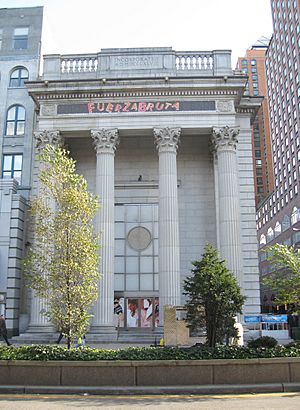Daryl Roth Theatre facts for kids

Nighttime exterior view of the Union Square Savings Bank building, now the Daryl Roth Theatre
|
|
| Address | 101 East 15th Street Manhattan, New York City United States |
|---|---|
| Coordinates | 40°44′07″N 73°59′22″W / 40.73528°N 73.98944°W |
| Owner | Daryl Roth |
| Type | Off-Broadway |
| Capacity | Daryl Roth: 299–499 DR2: 99 |
| Current use | Cyrano, Paddington Gets in a Jam |
| Construction | |
| Architect | Henry Bacon |
The Daryl Roth Theatre is a special place for performances in New York City. It's an "Off-Broadway" theater, which means it's a bit smaller than the huge Broadway shows. You can find it at 101 East 15th Street, near Union Square. The theater opened in 1998. It's inside a beautiful old building that used to be a bank! This building, called the Union Square Savings Bank, was built a long time ago, between 1905 and 1907. It was designed by a famous architect named Henry Bacon. The main theater can hold up to 300 people sitting down or 499 standing. There's also a smaller theater, the DR2 Theatre, next door at 103 East 15th Street, which seats 99 people.
Contents
History of the Building
From Bank to Theater
The Union Square Savings Bank started in 1848. It was first called the Institution for the Savings of Merchants' Clerks. The bank moved several times. In 1867, it bought a building near Union Square Park. The area around Union Square became very busy. Many hotels, theaters, and shops opened there. Banks at that time often built grand, standalone buildings.
In 1895, the bank bought the building next door. They tore down both old buildings. The bank changed its name to Union Square Savings Bank in 1904. They decided to build a new, bigger bank. They hired Henry Bacon, a well-known architect, to design it. The new building was made of granite and cost a lot of money. Construction began in May 1906. The new bank opened its doors on March 7, 1907.
The Union Square Savings Bank grew over the years. It opened more branches starting in 1923. The original building stayed its main office. A new office annex was added next door in 1955. The bank merged with another bank in 1969. Later, in 1982, the bank had problems and was taken over. The Union Square branch closed in 1992.
The Building Becomes a Theater
In 1993, a company called House of Blues bought the old bank building. They wanted to open a music venue there. People who cared about old buildings worried about changes. But the company promised to keep the bank's inside look. The project faced delays and problems getting a license. Local community groups were concerned about a concert venue.
In 1996, Daryl Roth bought the building. She had a plan to turn it into an off-Broadway theater. When it opened in 1998, people saw it as a new kind of theater space. The smaller DR2 Theatre opened in 2002. It was in the old bank annex next door.
For many years, the show Fuerza Bruta played there. During this time, people entered through a side door. The main entrance on Union Square was not used. In 2017, director Frank Oz changed this. He made the beautiful front doors on Union Square the main entrance again. This meant moving the box office. Now, audiences can enter through the grand front of the building.
Building Design
The Daryl Roth Theatre building is about 52 feet wide. It is 125 feet long and 60 feet tall. It has four stories. When it was a bank, it was one of many "monumental" bank buildings. These banks often looked like ancient Greek or Roman temples. Architects in the early 1900s used Renaissance and neoclassical styles.
The building has a strong foundation made of brick. Its outside is covered with white granite. Inside, brick walls and pillars support the structure. The upper floors are held up by metal columns and beams.
Outside Look (Facade)
The main front of the building faces Union Square. It has a portico, which is like a porch with columns. Four tall Corinthian columns support this portico. A few steps lead up to the main entrance. Above the columns, there is a decorative band called an entablature. At the very top, a cornice has carvings of lions and other designs. The main entrance has tall glass doors. These doors used to lead to the bank. Now, they lead to the theater's main room.
The side of the building, facing 15th Street, has five sections. Each section is separated by flat columns called pilasters. These pilasters also have Corinthian-style tops. Each section has large windows with bronze bars. Carved panels are above these windows. There is also a side entrance on this street.
- Architectural features of the Daryl Roth Theatre
Shows and Productions
As of October 2019, the Daryl Roth Theatre has hosted over 33 shows.
- Fuerza Bruta was a very popular show. It played at the theater from 2006 to 2016.
- Striking 12 ran from November to December 2006.
- Gloria: A Life opened in October 2018 and closed in March 2019.
The smaller DR2 Theatre has also hosted many shows.
- Bunnicula played there from February to April 2013.
- That Golden Girls Show ran from October 2016 to January 2017.
See also
 In Spanish: Teatro Daryl Roth para niños
In Spanish: Teatro Daryl Roth para niños









